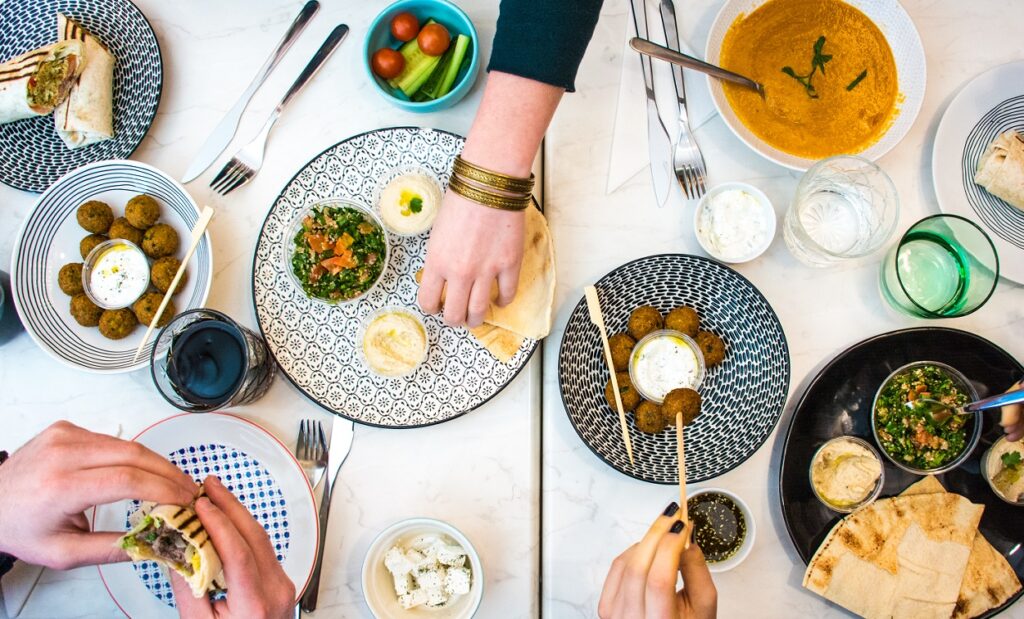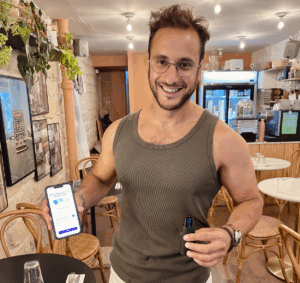Since the boom in foodtech and all its counterparts, it seems difficult today for a restaurateur to do without digital. But which partners should we work with? Who do delivery solutions benefit, and is it really profitable for the restaurant owner? I'll take stock with you!
Also find my ultimate guide to opening and growing your restaurant!
The question of profitability
Before going any further, be aware that this is a fairly technical subject and the outcome will be specific to each business. In other words, working with a marketplace (JustEat, Deliveroo, UberEATS, etc.) will be more or less profitable depending on the following parameters:
- Your gross margin rate
- The commission rate that you negotiated with the said marketplace
- The share you give to delivery activity compared to on-site
- The financial and operational sacrifice that you will be prepared to make for an activity that is a priori unprofitable but which offers visibility in terms of communication
So, as you will have understood, the answer is much more complex than it seems. Let's now move on to the different solutions available to you in terms of food marketplace.
UberEATS, the juggernaut
Behind UberEATS, there is obviously Uber. As a result, this solution guarantees you increased visibility and a certain volume of orders. Here are its main characteristics:
Do you have a business and want to regain control of your margins and your business model? Discover my solution Ultimate Business Dashboard which transforms your raw accounting data into performance indicators and a monthly dashboard.
- Strong demand on the outskirts of Paris and large cities, as well as in the suburbs.
- The exclusivity signed with the Big Fernand and McDonald's brands makes UberEATS a must, which can bring you a lot of visibility
- But be careful, these exclusivities with large brands can “gobble up” the potential volume of your orders, especially if you are a small structure that produces quality food. Your restaurant risks being drowned out by large, low-quality brands. It will therefore be tempting for you to favor the quantity over the quality of your products to align yourself with these major brands, but unlike them, you will not have their impact in terms of image, and not as much influence either. economies of scale than these big brands.
- Poor customer support for the end customer, which can be detrimental to your brand. In fact, many customers call the restaurant, already underwater, hoping to have technical support related to their delivery.
- A commission that revolves around 30%.
- And finally, no VAT on the commission, which simplifies cash flow processes.
Deliveroo, the city dweller
Although its image is a little damaged by delivery strikes, Deliveroo still has a better image than its competitor UberEATS in city centers. If you are a brand focused on quality products, Deliveroo may quickly be interested in you. For more “junk food” brands, unless you are a famous brand, it will be more difficult to join their marketplace. Here are the features of Deliveroo:
- Strong demand in the center of Paris and large cities, with a fairly demanding “bobo” clientele. So choose quality over quantity.
- An exclusive signed with partners with a good image such as Sushi Shop, in accordance with the image sent by Deliveroo.
- Very good customer support, both for the restaurant owner and for the end customer.
- A commission that revolves around 30%.
JustEat, the history
JustEat, the new name of Alloresto, is the historic player in the French market (bought by JustEat). It has therefore retained certain stigmas, such as the somewhat outdated user experience but which is being modernized year after year. Just Eat is characterized by:
- Strong demand in provincial towns and the Paris region. Less in the heart of large cities, because it is quickly followed by its more modern competitors who have come to divide the market.
- A somewhat catch-all directory, in which you will be drowned, unless you are a well-known brand or have made a name for yourself.
- Quite long customer support with poor sound quality.
- A commission which is around 15%, but you will either have to deliver with your own fleet, or use Stuart couriers, via the JustEat dashboard.
Is working with JustEat profitable?
With JustEat you have to deliver your own orders yourself. To the 13 to 15% commission, will therefore be added the cost of delivery that the restaurant will have to bear itself. However, the experience that I have acquired in this field allows me to estimate the delivery costs which are as follows:
- Between 14 and 18€/hour (all charges included) for recruited delivery people, to whom you will have provided scooters, gasoline, equipment and insurance. Check with Scootlib, Cooltra or CruisRent for scooter rental.
- Between 15 and 20€ excluding tax / hour for delivery people made available with their scooters by external courier companies (see Coursierprive.com).
- Between €8 and €12 / Ride (no VAT) with a Stuart courier on demand, depending on the distance to be covered.
If you have volume, you have every interest in insourcing delivery, because you will make economies of scale. Otherwise, you can use Stuarts couriers, but you will need to have fairly high average order baskets in order to compensate for the 15% commission + the 8 to 10€ for Stuart couriers.
The big problem if you don't have volume and decide to go with Stuart is that this solution is at your own risk. If Stuart does not have delivery people at the moment, or if you come across a novice courier or one who is simply not very skilled (this happens from time to time), your customers will not be delivered or 1 hour late, which will be counterproductive for you in terms of loyalty and image, especially during rush hours or rainy days. And no matter how much you complain about Stuart, you will still pay for the “failed” races.
If, on the other hand, you have your own delivery people, you have every interest in having volume, otherwise you risk losing money, with delivery people paid by the hour but who do not do enough shopping.
Generally, with its own fleet and a relatively “standard” gross margin rate (even if that doesn’t mean much), your internal delivery person should be able to deliver orders for at least €80 including tax/hour. This doesn't necessarily happen often, and the activity is often unpredictable, so beware of getting into debt!
Working with Deliveroo, is it profitable or not? What does the restaurateur really gain?
Here are some answers.
You should know that Deliveroo charges a percentage of the turnover including tax made by the restaurateur and the result of this percentage – the commission – is in HT on the bill. On this amount excluding VAT, Deliveroo legitimately applies a VAT of 20%.
This is why this marketplace pays you an amount lower than what you expected, because you will have advanced the deductible VAT by paying them a commission including tax. But don't panic, you will recover this VAT, since it is deductible, when you file your VAT returns.
Having trouble keeping up? Let's take an example !
Example with Deliveroo
Let's imagine that the commission negotiated with Deliveroo is 30%. Let's say that the end customer orders for €100 including tax. Deliveroo invoices the restaurateur 30% excluding tax on the amount including tax, i.e.:
0.30 * 100 = €30 excluding tax.
On this €30 excluding VAT, we must take into account the fact that Deliveroo applies a VAT of 20%, and that he will legitimately take his commission from you including tax, and not excluding tax, hence an amount paid back less than 70%.
In our example, Deliveroo therefore charges the restaurateur €36 including tax (and not 30€ excluding tax). The difference of €6 represents an amount of deductible VAT, which will be reimbursed to you by the State – but to which you will have to remit an amount of VAT collected – but we will come back to this at the final stage of the reasoning.
If you don't understand how we arrive at €36 including tax, don't panic, just apply the following formula:
Conversion formula between price including tax and price excluding tax:
Tax included = excluding tax + excluding tax * tax
VAT included = VAT * (1 + Tx)
In our example:
Price including tax = 30 * 1.20 = 36€
And if you don't want to do math, go directly to TVA.fr for conversions.
Let’s return to our example! Deliveroo will therefore pay the restaurateur the REMAINDER of the amount including tax, which in our hypothesis amounts to €100 – €36 = €64.
These €6 will be refunded to you when your accounting firm declares your VAT.
Now let's move on to the VAT collected
Once you have received €64, you will need to remit the VAT collected calculated on the basis of… €100 including tax! The basis to take is unfortunately NOT €64, nor €70, but rather the €100 paid by the end customer. Indeed, the State does not care that an intermediary has taken a commission of 30% excluding tax from you, for it, the sale made to the end customer is indeed €100 including tax.
Let's assume that you eat fast food, and without alcohol. Your VAT will therefore be 10%, which you will have to pay back to our dear State.
To calculate the VAT that you must remit based on €100 including tax, here is how to proceed:
VAT = tax included – excluding tax
In fact, the VAT amount is simply the difference between the amount including tax and the amount excluding tax. We will then use the formula previously mentioned, in order to determine the amount excluding tax of the €100 including tax sold to the end customer:
VAT included = VAT * (1 + Tx)
Excl. VAT = VAT / (1 + Tx)
Excl. VAT = €100 / 1.10 = €90.91
So VAT = 100 – 90.91 = €9.09
At the intermediate stage, you will therefore only have €64 – €9.09 = €54.91 left.
There, you say to yourself that it is average average in terms of profitability. But rest assured, you have paid Deliveroo a tax-inclusive commission from which you will be able to recover the VAT, since it is a deductible VAT. All is not lost !
The final step: deduct the deductible VAT
Remember. At the beginning, Deliveroo took €36 from you including VAT, due to VAT in 201TP3Q. This VAT is in fact a deductible VAT, which is opposed to collected VAT (the one you collect when you sell to the end customer).
Financially speaking, here is what you will really be left with in the end:
VAT balance = VAT collected – VAT deductible
VAT balance = €9.09 – €6 = €3.09
We therefore have a positive VAT balance, which means that we owe the State €3.09 at the end of this sale of €100 including tax via Deliveroo. In other words, we collected €9.09 from the end customer which we owe to the State, and we paid €6 to Deliveroo but which the State will reimburse us.
Conclusion: out of 100€ of sales, how much does the restaurateur have left?
On 100€ including VAT of sales on Deliveroo, with a VAT rate of 10%, and taking into account VAT declarations, the restaurateur will ultimately be left with:
100 – 30 – 6 = 64€
64€ – 9.09 = 54,91
54,91 + 6 = 60.91
Let's dissect this operation:
The restaurant makes a sale of €100 including tax. We must deduct from this sale the commission of 36% including tax. At this precise moment, the restaurant advances VAT.
Then, the restaurant must pay €9.09 in VAT, calculated on the basis of €100 including tax. Then he is reimbursed the €6 of deductible VAT that he has advanced. He therefore has €60.91 left.
On 100€ of sale, the sum remaining to the restaurateur is therefore 60.91€, or almost 61%. The latter is therefore amputated by… 39%! And not 30% as he might have initially thought.
In practice, here is the quick calculation to do with an order of €25.
In my example above, I deliberately dissected all the reasoning so that you understand why Deliveroo “only” paid you 64 and not 70%. But in practice, if you do your VAT declarations correctly (nothing is less certain!), you will recover these 6%. So, here is the quick calculation to do to go faster.
Let's take the case of an order for €25 (this is often the amount corresponding to the average basket in reality). Here is how you should proceed to calculate what you will have left from this order:
Price excluding tax of the commission = 25*0.3 = 7.5€
Price including tax of the commission actually collected = €9
Amount paid by Deliveroo = €25 – €9 = €16
VAT collected on the sale of €25 including tax = €2.27
VAT deductible from the commission of €9 = €1.5
VAT due to the State = €2.27 – €1.5 = €0.77
Amount actually received by the restaurant = €16 – (€2.27 – €1.5) = €16 – €0.77 = €15.23.
To make it simpler, now that you understand that you are going to recover the VAT, you can “skip” the phase linked to the latter, and consider that out of €25 of sales, the amount actually received by the restaurant is:
25€ – 7,5€ – 2,27€ = 15,23€
On 25€ including tax of sale, the sum remaining to the restaurateur is 15.23€, or 61%.
Please note: this “loss” is obviously not the fault of Deliveroo. This is due to the fact that the calculation of the VAT collected is based on the €25 including VAT of sales invoiced to the end customer and not on the €17.5 paid by Deliveroo.
This therefore does not mean that Deliveroo has “hidden fees”, since in all cases, for a sale at €25 including tax, you would have had to repay the VAT collected. You just have to take into account that in addition to the 30% commission, there is added the VAT collected, which is starting to add up to a lot in terms of charges, and which will have to be integrated into your economic model.
The choice of UberEATS, a little simpler
With UberEATS, things are a little less complicated. In fact, this international mobility giant does not have VAT on its invoices because it does not pay its taxes in France.
Therefore, if we take our example of €100 including tax invoiced to the end customer through this business provider, with the hypothesis of a commission of 30%, you will be left directly with 70%, which is clearer for you when you receive your payments.
Then, you will still have to, as a fast food restaurant for example, remit the 10% VAT collected to the French State. At the end, you will be left with the same thing:
100 – 9,09 = 60,91€.
The difference is that you do not make a cash advance: the payment corresponds immediately to 70%, and in this business with very low margins, every euro counts.
The increase in turnover can therefore mean loss of margin
Catering shows an average gross margin of around 70% on site. Let’s take the example of the €25 order again. If the restaurant has €15.23 left, it will need to deduct the cost of raw materials, which is generally around 30%, in order to know the gross margin.
As a reminder: Gross margin = Sales of goods (excluding tax) – Cost of purchasing goods (excluding tax)
So here, without intermediary: €22.73 – 0.3(22.73) = 22.73 – 6.819 = €15.91
With delivery intermediary: 15.23 – 0.3(22.73) = €8.41
Suffice it to say that the final profitability is shrinking like nothing else. And beware of the increase in costs, and in particular the payroll, which could tempt the restaurateur in the face of the influx of orders! In this case, the net result could even become… negative!
But then, who is the big winner of this four-cushion game?
Undoubtedly the end customer, who has the luxury of having a meal delivered, often fresh and cooked to order.
The semi-loser is the intermediary, who is often in a position dependent on investment funds, because he is unprofitable. However, even if most of these marketplaces reinvest in technology, which is commendable in order to improve their services, a huge sum is allocated to advertising, in order to force all competitors to retreat. And it is in particular this fight to the death which sometimes prevents the profitability of marketplaces.
Finally, the big loser is the restaurant, which trades a little visibility for work that is often at a loss. However, there is a main advantage to working with these partners: if there are no sales, you – a priori – lose nothing.
What is the point of delivering via marketplaces?
There are several reasons to be open to delivery.
- Don't miss the digital shift
- Gain online visibility
- Bring additional turnover, without guarantee of profits
- Challenge your staff
- Improve the turnover of your goods
In all cases, the restaurateur will need to find a balance between his direct on-site/takeaway sales and his sales on the platforms.
Tips for reducing losses with this type of intermediary
- Negotiate with the intermediary, and why not sign an exclusivity agreement in order to lower the commission.
- Do not base your business model solely on this, unless you have negotiated a low commission and ensured that you have a high gross margin rate.
- Improve your gross margin rate (up to 90% for low-quality sushi restaurants), but beware of the loss of quality of your products.
- Be careful not to spend extra on this bonus activity, unless you have calculated that it was indeed profitable.
- Ensure that your established staff can manage both delivery and on-site. Often, one takes precedence over the other, to the detriment of customer satisfaction.
- Try to reduce packaging costs as much as possible by reducing packaging and negotiating with your supplier. On JustEat and Deliveroo, cutlery and napkins are mentioned when the end customer needs them or not, which is a very good thing from an ecological point of view.
- Offer higher prices for delivery, but most marketplaces prohibit this practice (this is particularly the case with Deliveroo and JustEat).
- Invent special menus for delivery, on which you know you will make a profit, and which will suit the end customer.
An alternative solution: internalize delivery.
Like Frichti or FoodChéri for virtual restaurants, or Sushi Shop and Planet Sushi for franchises, to internalize delivery you will need a big brand image, a very loyal customer base, strong products, a fleet of delivery people and technology that follows the route (dispatch solution, mobile ordering application, etc.). We might as well tell you that it is another profession, which is far from that of restaurateur. 2020 update: I made it an article in its own right, which can be found here 😉
Also find my ultimate guide to opening and growing your restaurant!






6 Responses
Good morning,
You put Stuart in the title and you don't mention him?
Louis
Hello, how to set up delivery people as a digital restaurateur?
I provide a networking platform for the sale of dishes.
For me, it's very simple, I set up a delivery service which only manages restaurants around my restaurant and my delivery service. Have the most quality restaurants and a commission divided by 2 for the restaurateur. Currently in the testing phase but the concept is popular with our own delivery people and cheaper prices for the restaurant owner and the end customer...
Thank you for sharing this feedback. How are the “14 – 18€/hour (all charges included) divided for recruited delivery people, to whom you have provided scooters, gasoline, equipment and insurance”?
A preview of an app other than Orderlord for managing delivery people?
Good morning,
I have a question regarding the case of delivroo and VAT.
How does this work in the case of a self-employed person who sells takeaway and who is not subject to VAT?
I think that your status not subject to VAT is not compatible with deliveroo because the state risks paying you VAT on your sales ordered on the platform. In addition, you must declare the total amount of the customer order (CA) and not what Deliveroo pays you after commissions and others.